Diagnosing Die Hard's craziest injuries: A professional weighs in
In reality, John McClane should have finished the film as a quadriplegic with bowel and bladder dysfunction
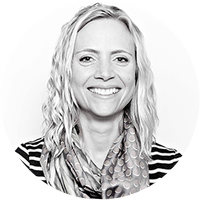

If you enjoy the holidays but cringe at the do-goodiness of sappy Christmas classics like It's a Wonderful Life, you should immediately add Die Hard to your annual viewing repertoire. The 1988 action thriller opens on Christmas Eve (Run DMC's "Christmas in Hollis" plays in the background), as hardened New York City cop John McClane (Bruce Willis) travels to Los Angeles to visit his kids and estranged wife, Holly (Bonnie Bedelia), who moved across the country for a job. Except instead of a romantic reconciliation at Holly's office holiday party, McClane finds himself in the middle of a deadly terrorist hostage situation.
To save the day, McClane single-handedly picks off half a dozen vaguely Eastern European terrorists led by Hans Gruber (Alan Rickman), engaging in several glass-crunching, blood-spattering, blow-heavy, bullet-riddled fight sequences. The muscle-bound, machine-gun-toting terrorists die spectacularly. The barefoot McClane somehow limps away at the end.
But wouldn't running over broken glass barefoot rip your feet to shreds? Wouldn't McClane break his neck falling down the stairs? Is it really possible to bungee jump 100 feet with a fire hose tied around your body and live to tell the tale?
The Week
Escape your echo chamber. Get the facts behind the news, plus analysis from multiple perspectives.

Sign up for The Week's Free Newsletters
From our morning news briefing to a weekly Good News Newsletter, get the best of The Week delivered directly to your inbox.
From our morning news briefing to a weekly Good News Newsletter, get the best of The Week delivered directly to your inbox.
To answer these questions, I spoke with my friend, Dr. Ryan St. Clair of the Palo Alto Medical Foundation. Enjoy.
The injury: Falling down a flight of stairs while fighting
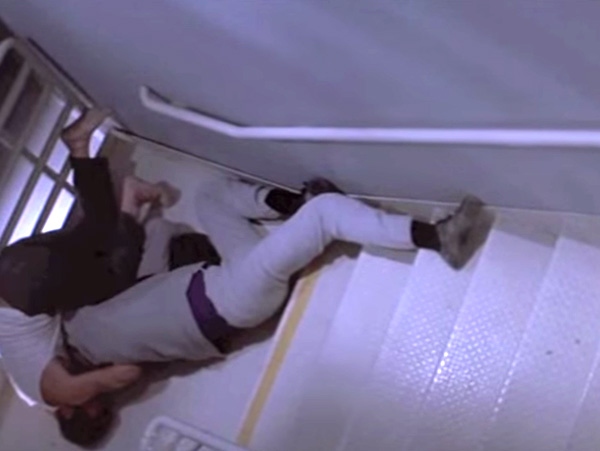
The set-up: John McClane takes on terrorist Tony, a tall blond German armed with a machine gun. The two fight close, Mortal Kombat-style, on an unfinished floor of the skyscraper where Holly works. McClane jumps on Tony's back. They wrestle through sheet rock and eventually crash through a stairwell door. McClane cushions Tony's initial fall on the landing before the entwined pair tumble down a short flight of stairs. Tony lands first at the bottom, with McClane on top, wrapped around Tony's neck and head.
The doctor's diagnosis: People die from falling down the stairs. The two most common causes of death are subdural hematoma (bleeding into the space between the brain and the inner lining of the skull) and cerebral edema (swelling of the brain tissue after blunt trauma). Twice as many males as females died from stair falls, according to a 2009 study, and most deaths occur in patients 31 to 40 years old. On its face, that sounds like our man Tony. (McClane's probably alright, since he lands on top of Tony.)
A free daily email with the biggest news stories of the day – and the best features from TheWeek.com
But while it is possible that Tony would be knocked unconscious by this fall, it is unlikely that he would die immediately. Subdural hematoma and cerebral edema resulting from head trauma do not cause instant death at the time of injury; death typically results from pressure on the brainstem as the contents of the skull swell and push the brain toward the base of the skull. Prolonged pressure on the brainstem damages the neurons, which govern breathing, causing a gradual loss of consciousness, and ultimately death, several hours to several days after the injury. It is possible that Tony is still alive, but unconscious and deteriorating, when McClane dresses him in a Santa hat and sends him down in the elevator to meet the other terrorists. If only his brother Karl had gotten him to a neurosurgeon in time, Tony might have lived.
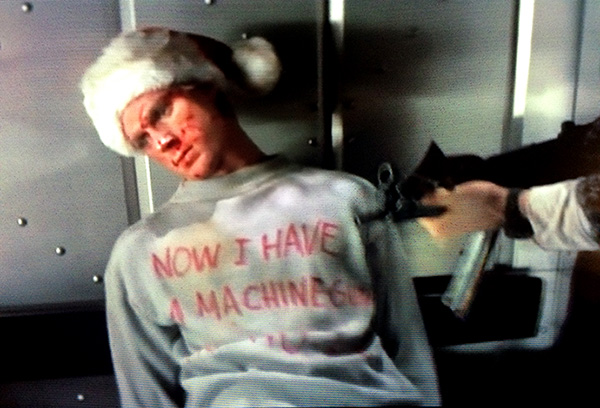
**
(Related — Diagnosing the Home Alone burglars' injuries: A professional weighs in)
**
The injury: Running barefoot over broken glass
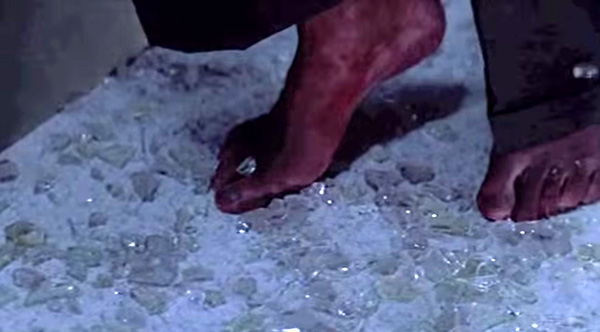
The set-up: McClane is fleeing at least three terrorists armed with machine guns. Noticing McClane isn't wearing any shoes, they shoot out all of the glass in the office space, creating a carpet of broken shards between McClane and the exit. The only way out is to sprint to the door, which our hero does. We later see McClane drag himself, blood streaming from his feet, into a bathroom, where he picks large pieces of glass out of his left foot. He bandages the worst of it and appears to favor his right foot moving for much of the rest of the film. He never does get a pair of shoes.
The doctor's diagnosis: McClane's feet would undeniably be badly cut. Based on the size of the glass fragments, he would at least need proper suturing and oral antibiotics. A typical person would be in considerable pain and might not be able to walk. But, of course, John McClane is not your typical person.
More concerning than the immediate wound is the retained glass in McClane's foot. Retained glass, if not removed properly, can cause granuloma and cheloid formation (abnormal, possibly painful scarring) and increases the likelihood of serious infection. After patching things up with his ex-wife, McClane should pay a visit to the podiatrist.
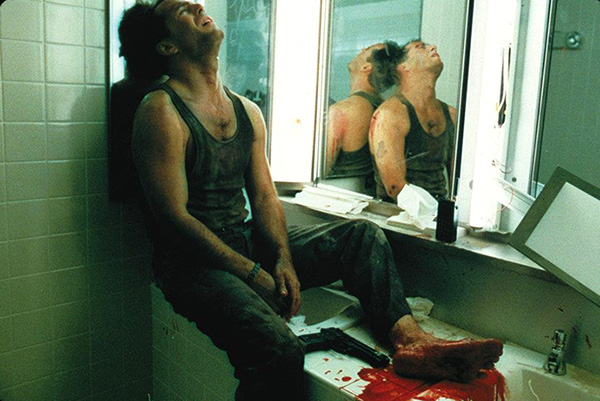
**
The injury: Gunshot wound to the shoulder
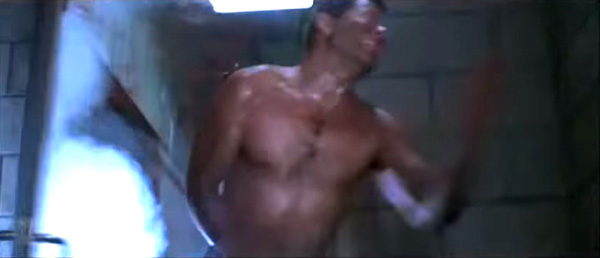
The set-up: In this lengthy fight scene, McClane and the terrorist Karl go hand-to-hand until Karl gets a hold of a handgun and fires it at McClane, who tries to slip out the door. The bullet hits McClane in the right shoulder (McClane screams in pain) and blood splatters against the concrete. Despite the injury, McClane continues his brawl, which ends with a dead Karl dangling from a metal chain.
The doctor's diagnosis: Upon careful review of this scene, it appears that McClane sustains a grazing bullet injury to his right shoulder during his fight with Karl. If the wound is superficial, does not lacerate an artery, and does not cause significant damage to the deltoid muscle, it is not impossible that McClane could shrug it off and keep fighting.
Handgun bullets can be very hot when fired. While on the trauma service in Newark, New Jersey, I saw several grazing gunshot wounds that were self-cauterized (meaning the wound was burned to stop the bleeding) by the heat of the bullet and bled very little. It is possible that McClane would bleed much less from this wound than he does in the film.
Still, getting shot is a serious injury. And it hurts! It's not the most plausible situation to best a muscle-bound terrorist in a fight to the death moments after being shot.
**
The injury: Bungee jumping 100 feet with a fire hose and crashing through the glass facade of another floor

The set-up: In this climatic action sequence, McClane grabs a fire hose from its coil, wraps it around his waist, and jumps off of the skyscraper's roof just as the terrorists blow it up. McClane falls until the metal coil catches on the lip of the building. He bounces and smashes against the outside windows. Now caught precariously thousands of feet in the air, McClane shoots at the glass, and manages to crash through (bloody feet first) onto one of the floors just as the metal coil unclips from the roof and falls. McClane manages to untie himself from the hose just as it plummets to the ground.
The doctor's diagnosis: Let's assume McClane falls 30 meters (98 feet) before the hose stops him. If McClane weighs 70 kilograms (220 pounds), falls 30 meters, and is stopped by a fire hose made of relatively inelastic material, which extends by only 1.5 meters when stretched, he experiences a force of 14.6 kilonewtons. U.S. Air Force guidelines state that the human body cannot endure more than 12 kilonewtons under similar circumstances without serious injury. Also, McClane is not wearing a harness, which means the entire force of the fall is transmitted to his spine. Ouch.
The most likely spinal cord injuries McClane would experience from this type of fall are fractures of the C5 through C7 vertebrae. Those are in the neck. Assuming a broken neck doesn't kill him, injury of the C5 to C7 area of the spinal cord typically causes complete or incomplete quadriplegia (loss of movement and sensation in all four limbs), with bowel and bladder dysfunction, sexual dysfunction, and difficultly maintaining proper heart rate, blood pressure, and body temperature.

The doctor's conclusion: Based on the injuries McClane would likely receive during the events of Die Hard, I feel it is doubtful that he would wave away the ambulance, hop in a limousine with Holly, and ride home in the film's final scene. Months of intensive hospital recovery are more likely. By the time McClane meets the Dulles International Airport terrorists in Die Hard 2, he would likely be dependent on a motorized wheelchair and home nursing care, with limited (at best) use of his arms. I would watch that movie.
Lauren Hansen produces The Week’s podcasts and videos and edits the photo blog, Captured. She also manages the production of the magazine's iPad app. A graduate of Kenyon College and Northwestern University, she previously worked at the BBC and Frontline. She knows a thing or two about pretty pictures and cute puppies, both of which she tweets about @mylaurenhansen.
-
 Political cartoons for January 4
Political cartoons for January 4Cartoons Sunday's political cartoons include a resolution to learn a new language, and new names in Hades and on battleships
-
 The ultimate films of 2025 by genre
The ultimate films of 2025 by genreThe Week Recommends From comedies to thrillers, documentaries to animations, 2025 featured some unforgettable film moments
-
 Political cartoons for January 3
Political cartoons for January 3Cartoons Saturday's political cartoons include citizen journalists, self-reflective AI, and Donald Trump's transparency
